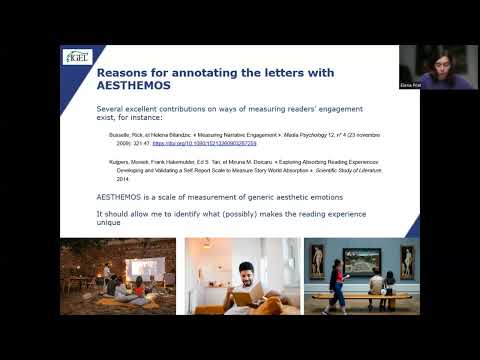 Speaker: Elena Prat
Speaker: Elena Prat
 Affiliation: Le Mans Université
Affiliation: Le Mans Université
Title: Exploring the semiotics of reading emotions through an innovative annotation tool for text-based sources : a preliminary study based on a sample of letters written by French contemporary readers.
Abstract (long version below): This paper aims to contribute to the scholarship on the semiotics of reading emotions. It presents an annotation experiment conducted on 10 letters by French ordinary readers, applicants to the jury of a literary prize in 2010.
The sample was annotated with a tool developed by the European project READ-IT. Reading emotions were labeled based on the 21 subscales included in AESTHEMOS, an assessment tool for aesthetics emotions.
Whilst still preliminary, the results open up some promising perspectives with regards to the construction of an annotated dataset of reading emotions, suitable for being further enriched and compared with other datasets.

 Long abstract
Long abstract
This paper aims to contribute to the diversity of sources in empirical literary aesthetics by exploring the semiotics of reading emotions in a sample of letters written by French contemporary readers. The analysis, supported by the READ-IT annotation tool, attempts to provide a preliminary set of annotations suitable for comparison with similar datasets in French as well as in other languages. By doing so, I hope to contribute to creating a shared space to collect and explore multilingual testimonies of readers across space and time.
Methods
The present study was conducted on a sample drawn from a corpus of more than 2,600 letters of candidates to the jury of a popular literary prize, the Prix du Livre Inter, in 2010 and 2011. In their letters, candidates recount early memories of reading and describe their impressions of contemporary and classic authors and reading materials. The corpus was acquired in 2021 with special permission from the French National Archives. For this paper, I have created a sample of 10 letters from 2010. The distribution by gender and type of letters (typed and handwritten) is consistent with the original corpus.
To explore the sample, I am testing a newly-created annotation tool (currently in its beta version), embedded in the interface developed by READ-IT, a R&D project (2018-2021) coordinated by Brigitte Ouvry-Vial (Le Mans Université). The project collects and explores readers’ testimonies across Europe, from the 18th century to the present day. The annotation tool provides 5 macro-categories (resource, reader, act of reading, effects and outcomes) and 43 sub-items which can be further labeled by the annotators. Moreover, the tool enables semantic research across the annotations and therefore allows to compare readers’ responses across time, media, linguistic communities etc.
Firstly, I have annotated all letters based on the 43 sub-items, with the aim of recording the main features of the reader, the reading resources, the context of the reading experience and the response of the reader to it. Secondly, I have focused on readers’ aesthetic emotions, a sub-item of the macro-category “effects”.
I have labeled aesthetic emotions in the letters based on the Aesthetic Emotions Scale (AESTHEMOS), a framework suitable for annotating aesthetic emotions across all main artistic domains (Schindler et al. 2017). AESTHEMOS includes four main categories of aesthetic emotions (prototypical aesthetic emotions, pleasing emotions, negative emotions, epistemic emotions) and 21 subscales differentiating the features of emotional responses to the aesthetic qualities of a stimulus.
Results
I was able to annotate 73 emotions across the 10 letters, corresponding to 9 out of the 21 subscales of AESTHEMOS.
The directionality of these emotions appears to be mixed: it is associated to both specific literary works across genres and to the act of reading in general, as well as to style, content and haptic features in the reading media. Based on the limited sources I had, I wasn’t able to identify any shared pattern in the association of different terms with specific objects. Nevertheless, such aspects certainly deserve a more in-depth analysis, to be conducted through textometry tools such as TXM, and on a larger sample.
Readers express emotions associated with current and previous reads alike. Emotions linked with reading experiences during childhood and adolescence are often described as particularly intense and vivid, and they mostly fall under the macro-categories of pleasing and epistemic emotions.
Whilst the sample is not large enough to provide any quantitatively relevant outputs, it does lay out some promising preliminary results with regards to the combined use of the READ-IT annotation interface and AESTHEMOS. The interplay of the two allowed me to create a dataset of annotations of aesthetic emotions suitable for further semantic and textual analysis within the corpus as well as in a comparative perspective.
In future developments of my research, I intend to enlarge the corpus and to explore, through close and distant reading, other aspects of aesthetic appraisal of literature, such as the degree of legitimacy that readers attribute to their reading emotions.

